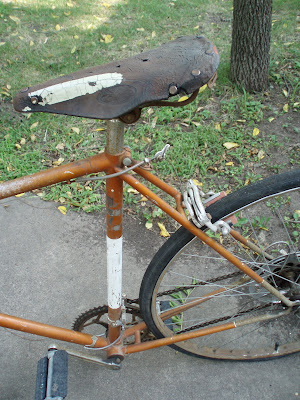(2nd in a series of 3)
Trying to find materials was very daunting at first. It seemed like everywhere I looked online people were selling a minimum of 1 yard of carbon fiber cloth (in widths varying from 3'-5'). This is way more material than I needed and I figured that if I bought a yard of several different weaves, plus a peel-ply, and probably way more epoxy than I needed, I would probably be getting pretty close to 50% of the cost of a professional carbon bike frame repair (which seemed to run about $300).
 |
| Most of my supplies. |
However, after much more searching, I found that US composites sold carbon fiber fabric "tape" (which just means that the widths are narrow....like, 3" to 6"). I ended up order the 12k cloth 6" wide by 2' long, plus a small (20 oz.) quantity of their epoxy resin and hardener. The total cost for these materials was $20 + shipping. I probably spent another $25 on other random materials (foam paint brushes, good electrical tape, clear coat spray, rubber gloves, etc.). I also bought some graphite powder, which I didn't end up using.
 |
| My "layup schedule": progressively wider swatches with alternating weave angles (0/90 degrees, 45/315 degrees), then a patch of old rip-stop nylon as my "peel ply", and finally a semi-rigid cardboard cut-out to help provide pressure on the chain stay's inboard side where the rectangular tube wall is a bit concave. |
To figure out what sizes, shapes, weave orientation I would use, I started by cutting out a scrap piece of plastic and laying it across the repair area in various ways. Then, I used it as a pattern to cut the cloth. I'm a total newbie, so I have no real expertise in figuring out what is ideal. I searched a few forums and found myself looking down a very deep well of knowledge and theory about strand orientation and decided to go more with the 'gut-feeling' layup.
In preparation for the layup, I cut several lengths of Scotch Super 33 electrical tape and perforated them with many pinholes. This will allow the excess epoxy to seep out when tightly wrapped.
 |
| Perforated electrical tape (the premium stuff: 3M Super 33 for extra elasticity); this will serve to compress the layup schedule in lieu of a vacuum bagging set up. |
For a job this small, not much epoxy is necessary. I mixed it in small batches. In the photo it's on a scale, but I ended up not measuring the parts by weight (since I was mixing such small amounts) - instead, I used the small measuring cap included with the bottle, measuring out 1 part hardener to 3 parts resin.
 |
| Mixing some epoxy: US Composites 365 system - 3:1 medium |
I didn't take any photos mid-layup because it's a tacky mess that camera would not have survived. Basically, I just used my foam brush wet down each swatch of carbon fiber with the epoxy and then very carefully laid the wet swatch in its position on the frame. The 12k carbon fiber cloth I used isn't very supple...it doesn't lay down really easily, so I had to be extra patient with it and use the epoxy liberally. I laid three progressively larger swatches of carbon fiber on the frame, alternating the weave orientation (0/90 degrees, 45/315 degrees). Once all three swatches were in place and relatively flat, I carefully covered it with the rip-stop nylon scrap and then started tightly wrapping the whole thing with my electrical tape.
 |
| After everything is set and taped, I made my own little hot box (light bulb + tin foil + plastic storage box = a constant 95 degrees). The layup sat like this for 10+ hours to cure. |
After I had a layer of electrical tape wound around, I applied my semi-rigid cardboard braces, and taped a little more. I was mainly concerned that the inboard wall of the rectangular chain stay tube was vertical, or slightly concave, and would therefore not receive as much pressure from the electrical tape wrap. I knew that the rectangle's corners would receive a disproportionate amount of pressure. So in an attempt to more evenly distribute the tape-wrap's pressure, I added the cardboard.
 |
| 95 & sunny: just right! |
My home made hot box was keeping a consistent 95 degrees, which was just right for the epoxy system I was using. It sat at this temperature overnight.
After 10+ hours in the hot box, I was dying to see how things would look. Would my peel-ply layers come off or would I have to sand through them?
 |
| After curing, I was a little apprehensive about how well the tape would come off, but it was not difficult at all. |
 |
| I was even more skeptical that the rip stop nylon would detach...but it came off just fine also. |
 |
The final layer of carbon fiber cloth.
|
After sanding the original 3-ply layup schedule, I decided a fourth & final layer was in order. I figured I could achieve a better aesthetic working with just one single layer. From the the previous layup I had seen how well electrical tape works as a peel-ply, so I didn't even bother with the rip-stop nylon on this one. I sanded the patch area smooth, wet it down with epoxy, wet down the carbon fiber cloth with epoxy
In my next post.....
I should just have to sand the whole area with progressively finer grits (down to wet-sanding / steel wool), and then apply some UV protective enamel and final finishing coats.
For next blog post, click here!

































